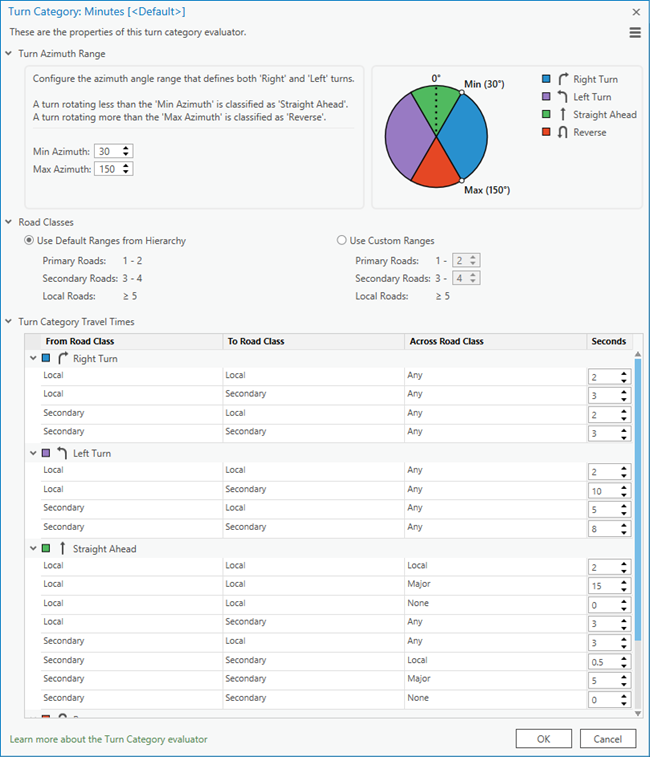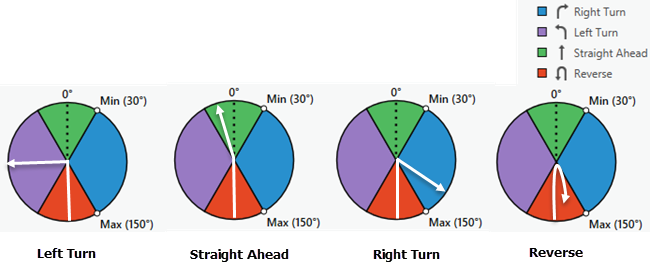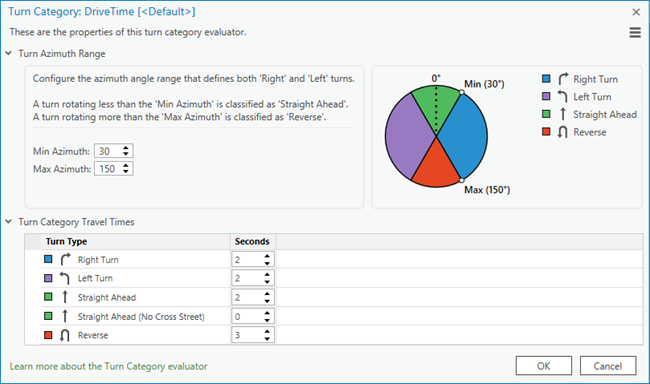Turns are implicitly present at every transition between two adjacent edges within a network dataset where there is not already a turn feature present. The main purpose of the turn category evaluator is to improve travel time estimates by penalizing turn movements that are not already represented or are restricted by turn features.
The turn category evaluator works by first classifying two-edge transitions into four general turn types: left turn, right turn, straight ahead, and reverse. Second, the evaluator delays transitions between edges based on the values you provide. For example, if you give left turns a turn delay of 15 seconds, the evaluator finds all adjacent edges that are left turns and delays them by 15 seconds. The evaluator is able to use hierarchies to classify and delay turns more accurately. For instance, it can recognize a left turn from a local road to a secondary road and delay it more than a left turn from a local road to another local road.
The turn category evaluator can be used with or without turn features present in a network dataset. Creating turn features for every turn, or even most turns, in a network is often infeasible because of the quantity of turns that are possible. In this case, you can set up turns by defining turn angles for the four turn directions and assigning delays for each turn type using the turn category evaluator. You should note that turns are typically not as accurate as turn features, because they are generalized and only delay two-edge turns.
Once a turn category evaluator is assigned as the default turn evaluator of a time cost attribute, turns are delayed anytime you use that cost attribute within a network problem either as the impedance or an accumulated attribute. The azimuth values of a turn evaluator can be changed without requiring a rebuild of the network dataset.
Turn Azimuth Range
Turn azimuth is used to classify movements between adjacent edges into straight, reverse, right, and left turns. The Turn Azimuth Range section allows you to set right and left turn azimuth range, which implicitly sets straight and reverse turns. Both right and left turns have minimum and maximum values of 30 and 150 degrees by default. Azimuth range for the right turns is clockwise, while for the left turn it's counterclockwise. You can specify turn azimuth range by typing the azimuth values in the Min Azimuth and Max Azimuth text box. Alternatively, you can also specify the turn azimuth values by dragging the range indicator points on the pie chart.
The turn category evaluator first evaluates the turning azimuth, and then it evaluates the road class. If the angle falls within the right turn range, it will make that determination first and, if necessary, inspect adjacent streets to determine road class.

Turn types
Turns are classified into four main categories based on their turn azimuth: Left Turn, Right Turn, Straight Ahead, and Reverse. A vehicle going through an intersection must perform one of these four turn types.
To demonstrate how a turn is classified into one of these four types, the white arrows in the pie charts below indicate the movement of a vehicle through an intersection. The pie chart, which is taken from the Turn Category evaluator dialog box, is oriented so that the vehicle approaches an intersection from the center of the red area at the bottom of the circle. When the turn angle from one edge to another edge points the vehicle toward the purple area, the vehicle has performed a left turn. When the vehicle angles toward the green area, it has performed a straight turn. Blue and red capture right and reverse turns, respectively.
A reverse turn is either a U-turn or a sharp turn greater than maximum azimuth turn rotation movement. A straight-ahead turn is when the turn rotation is less than the minimum azimuth.

Changing the azimuth that classifies turns is possible. For example, you can narrow the straight-turns wedge and widen the reverse-turns wedge, which consequently affects the left- and right-turn wedges. By doing so, the arrows that represent the straight and right turns in the pie charts above are correspondingly reclassified as left and reverse turns in the pie charts below.

Since the turn classification can change, the turn delay can also change. For instance, the original straight turn might have a turn delay of only 2 seconds, whereas the same turn, reclassified as a left turn in the second pie chart, might have a turn delay of 5 seconds.
Road Classes
If your network dataset has a hierarchy, the Road Classes section allows you to group road levels into the following road classes: primary, secondary, and local. If a hierarchy is not present on your network dataset, the turn category evaluator will treat all roads as local roads.
Road classes based on hierarchies
The time it takes to negotiate an intersection frequently depends on the volume of cross-traffic; moreover, traffic volumes are likely to correlate with road hierarchies. For instance, a left turn from a local road onto a secondary road typically involves waiting for a break in traffic or on a traffic light that favors the secondary road. Yet left turns from local roads onto other local roads tend to have a shorter delay, because there is less cross-traffic and usually only a yield or stop sign.
If your network uses a hierarchy, the turn category evaluator is enabled to model turn delay in more detail by classifying turns according to whether the two roads that are traversed are local, secondary, or primary roads, or any combination thereof. You could, therefore, choose to assign left turns from local roads onto secondary roads a turn delay of 10 seconds, while assigning left turns from local roads onto local roads a 2-second turn delay.
The turn category evaluator only works with three road class types. You can choose to use the default hierarchy ranges or define custom ranges by selecting the Use Custom Ranges option.
Learn more about the hierarchy network attribute
When your network doesn't use hierarchies, all turns are considered part of the same road class: local roads.
Turn Category Travel Times
The table in this section lists the turn types and their corresponding impedance values. To change a turn delay value, click a row in the Seconds column and enter a value, or use the Increment or Decrement buttons.
Turn delays are modeled using seconds. Consequently, the turn category evaluator can only be used with network cost attributes based on time (such as minutes or seconds).
You can estimate or measure the average number of seconds it takes your vehicle to make the various types of turns and assign those values to the corresponding turn types on the turn category evaluator dialog box.
Turn category without hierarchy
When your network doesn't use hierarchies, the Road Classes section is not present on the dialog box and all turns are considered part of local roads.